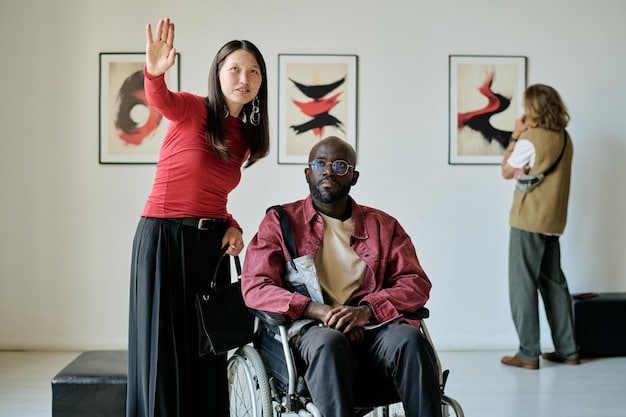Advancing Disability Rights in the US: Challenges and Opportunities for 2025

Advancing disability rights in the US in 2025 presents key challenges such as addressing healthcare disparities, ensuring accessible technology, and combating discrimination, while also offering opportunities to strengthen legal frameworks, promote inclusive education and employment, and foster greater community integration.
What are the key challenges and opportunities for advancing disability rights in the US in 2025? The landscape is complex, but understanding both hurdles and possibilities is crucial for progress.
Understanding the Current State of Disability Rights in the US
Before diving into the future, it’s essential to understand where we stand today. Disability rights in the US have come a long way, but significant gaps remain.
The Americans with Disabilities Act (ADA) of 1990 was a landmark achievement, prohibiting discrimination based on disability. However, enforcement and full implementation remain ongoing challenges.
Key Achievements and Ongoing Struggles
The ADA has led to increased accessibility in public spaces and employment opportunities. However, many individuals with disabilities still face systemic barriers.
Access to healthcare, affordable housing, and inclusive education are persistent challenges that need to be addressed to ensure equal opportunities for all individuals with disabilities.
Areas Where Progress is Lagging
Despite progress, significant disparities persist in areas like employment, wages, and access to technology.
- Employment Rates: Individuals with disabilities experience significantly lower employment rates compared to those without disabilities.
- Wage Gaps: Even when employed, individuals with disabilities often earn less than their non-disabled peers for similar work.
- Technological Access: The digital divide remains a significant barrier, as accessible technology and digital literacy initiatives are not universally available.
Recognizing these shortcomings is the first step towards creating a more equitable and inclusive society for individuals with disabilities.
Healthcare Access and Affordability for People with Disabilities
Healthcare access and affordability are critical components of disability rights. Ensuring that individuals with disabilities have access to quality, affordable healthcare is essential for their well-being and independence.
However, numerous barriers hinder healthcare access for this population, including insurance limitations, lack of accessible medical facilities, and provider biases.
Insurance Barriers and Coverage Gaps
Many individuals with disabilities face challenges in obtaining adequate health insurance coverage. Pre-existing condition exclusions and limitations on coverage for specific treatments or therapies can create significant financial burdens.
Additionally, out-of-pocket costs, such as co-pays and deductibles, can be prohibitively expensive for individuals with disabilities, particularly those with low incomes.
Accessible Medical Facilities and Equipment
Even with insurance coverage, accessing medical care can be challenging if facilities are not physically accessible. Ramps, elevators, and accessible examination rooms are essential for individuals with mobility impairments.
Furthermore, specialized equipment, such as adjustable examination tables and accessible diagnostic tools, are often lacking in healthcare settings, creating barriers to care.

Addressing Provider Bias and Training Deficits
Negative attitudes and biases among healthcare providers can also hinder access to care. Some providers may lack understanding of the unique healthcare needs of individuals with disabilities, leading to inadequate or inappropriate treatment.
Improving provider training and promoting disability cultural competence are crucial steps towards eliminating these biases and ensuring respectful, patient-centered care.
Addressing these healthcare barriers requires comprehensive policy changes, increased funding for accessible healthcare services, and ongoing efforts to educate and train healthcare professionals.
The Role of Technology in Promoting Inclusion and Accessibility
Technology has the potential to be a powerful tool for promoting inclusion and accessibility for individuals with disabilities. Assistive technologies, digital accessibility standards, and innovative applications can open doors to education, employment, and community participation.
However, realizing this potential requires addressing challenges related to affordability, access, and user training.
Assistive Technologies and Their Impact
Assistive technologies, such as screen readers, speech recognition software, and mobility aids, can significantly enhance the independence and quality of life for individuals with disabilities.
These technologies can enable individuals to access information, communicate effectively, and participate more fully in daily activities.
Ensuring Digital Accessibility and Web Compliance
As more aspects of life move online, ensuring digital accessibility is crucial. Websites, applications, and digital content must be designed to be accessible to individuals with disabilities, regardless of their assistive technology.
Compliance with accessibility standards, such as the Web Content Accessibility Guidelines (WCAG), is essential for preventing digital discrimination and promoting equal access to information and services.

The Digital Divide and Access to Technology
Despite technological advancements, the digital divide remains a significant barrier for many individuals with disabilities. Affordability, lack of access to internet services, and inadequate training can limit technology adoption and usage.
- Affordability: Assistive technologies and internet services can be expensive, creating a financial burden for low-income individuals with disabilities.
- Access: Lack of access to internet services, particularly in rural areas, can limit opportunities for online education, employment, and social interaction.
- Training: Adequate training and support are essential for individuals to effectively use assistive technologies and digital resources.
Bridging the digital divide requires targeted investments in affordable technology, expanded internet access, and comprehensive training programs.
Employment Opportunities and Workplace Inclusion
Employment is a critical pathway to economic self-sufficiency and social inclusion for individuals with disabilities. Creating inclusive workplaces that value diversity and provide equal opportunities is essential.
However, significant barriers to employment persist, including employer biases, lack of accommodations, and limited access to job training and support services.
Combating Employer Bias and Discrimination
Employer biases and negative attitudes towards individuals with disabilities remain a significant barrier to employment. Many employers underestimate the skills and abilities of individuals with disabilities, leading to discriminatory hiring practices.
Combating these biases requires education, awareness campaigns, and strong enforcement of anti-discrimination laws.
Promoting positive attitudes and showcasing the talents and contributions of individuals with disabilities can help break down stereotypes and create more inclusive workplaces.
Providing Reasonable Accommodations and Support
Reasonable accommodations are modifications or adjustments to the workplace or job duties that enable individuals with disabilities to perform essential job functions. Providing these accommodations is a legal requirement under the ADA.
Examples of reasonable accommodations include providing assistive technology, modifying work schedules, and making physical modifications to the workspace.
In addition to accommodations, ongoing support and mentorship can help individuals with disabilities thrive in the workplace. Mentorship programs can provide guidance, encouragement, and networking opportunities.
Enhancing Job Training and Skill Development
Access to high-quality job training and skill development programs is essential for individuals with disabilities to acquire the skills needed for competitive employment.
- Customized Training: Training programs should be tailored to meet the individual needs and goals of participants.
- Internships: Internships provide valuable hands-on experience and opportunities to demonstrate skills to potential employers.
- Apprenticeships: Apprenticeships combine on-the-job training with classroom instruction, providing a structured pathway to employment.
These initiatives require collaboration between employers, educational institutions, and disability service organizations.
Legal and Policy Frameworks: Strengthening Disability Rights
Legal and policy frameworks play a critical role in protecting and promoting disability rights. Strengthening existing laws and enacting new policies are essential for ensuring equal opportunities and full participation for individuals with disabilities.
This includes advocating for stronger enforcement of the ADA, expanding access to legal services, and promoting policies that support inclusive education, employment, and healthcare.
Enforcing the Americans with Disabilities Act (ADA)
The ADA is the cornerstone of disability rights in the US. However, enforcement of the ADA remains a challenge. Many violations go unreported or unresolved due to lack of awareness, resources, or legal support.
Strengthening ADA enforcement requires increased funding for regulatory agencies, enhanced public education campaigns, and improved access to legal services for individuals with disabilities.
Expanding Access to Legal Services
Many individuals with disabilities face barriers to accessing legal services, including financial constraints, lack of awareness of available resources, and physical or communication barriers.
Expanding access to legal services requires increasing funding for legal aid organizations, providing disability-specific legal training to attorneys, and promoting accessible communication formats.
Advocating for Inclusive Policies
In addition to enforcing existing laws, advocating for new policies that support inclusive education, employment, and healthcare is essential.
This includes advocating for policies that promote early intervention services, inclusive education practices, supported employment programs, and affordable healthcare options.
Collaboration between disability advocacy organizations, policymakers, and community stakeholders is crucial for advancing these policies.
Community Inclusion and Social Integration
Community inclusion and social integration are essential for ensuring that individuals with disabilities have the opportunity to live full and meaningful lives. This involves creating communities that are welcoming, accessible, and supportive.
Promoting community inclusion requires addressing attitudinal barriers, increasing accessible housing options, and fostering opportunities for social interaction and participation.
Addressing Attitudinal Barriers and Stigma
Negative attitudes and stigma towards individuals with disabilities can create significant barriers to community inclusion. These attitudes can lead to discrimination, social isolation, and limited opportunities.
Addressing attitudinal barriers requires ongoing education, awareness campaigns, and opportunities for individuals with and without disabilities to interact and build relationships.
Increasing Accessible Housing Options
Accessible housing is essential for individuals with disabilities to live independently and participate fully in their communities. However, accessible housing options are often limited, particularly in affordable housing developments.
Increasing accessible housing options requires incentivizing developers to build accessible units, enforcing accessibility standards in housing codes, and providing financial assistance to individuals with disabilities to modify their homes.
Fostering Social Interaction and Participation
Opportunities for social interaction and participation are essential for promoting community inclusion. This includes access to recreational activities, cultural events, and volunteer opportunities.
Creating inclusive community programs and activities that are accessible to individuals with disabilities can foster friendships, build social networks, and promote a sense of belonging.
| Key Areas | Brief Description |
|---|---|
| ⚕️ Healthcare Access | Addressing insurance barriers and improving accessible medical facilities for disabled individuals. |
| 💻 Technology & Inclusion | Promoting assistive technologies and ensuring digital accessibility to bridge the digital divide. |
| 🏢 Workplace Equality | Combating employer bias, providing accommodations, and enhancing job training for people with disabilities. |
| 🏡 Community Integration | Fostering social interaction, addressing attitudinal barriers, and increasing accessible housing options. |
Frequently Asked Questions
▼
The ADA is a civil rights law that prohibits discrimination based on disability. It applies to employment, state and local government services, public accommodations, and telecommunications.
▼
Assistive technologies like screen readers and speech recognition software, along with accessible digital content, enable individuals with disabilities to participate more fully in education, employment, and daily activities.
▼
Reasonable accommodations are modifications or adjustments to the workplace or job duties that enable individuals with disabilities to perform essential job functions. Examples include assistive technology and modified schedules.
▼
Community inclusion ensures that individuals with disabilities have the opportunity to live full and meaningful lives by creating communities that are welcoming, accessible, and supportive to their needs.
▼
Enforcement challenges include lack of awareness, limited resources, and attitudinal barriers. Stronger funding for regulatory agencies and public education campaigns are crucial to address these issues.
Conclusion
Advancing disability rights in the US in 2025 requires a multifaceted approach that addresses healthcare access, technological inclusion, employment opportunities, legal frameworks, and community integration. By prioritizing these areas, the US can create a more equitable and inclusive society for individuals with disabilities.





